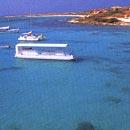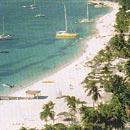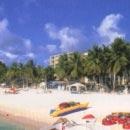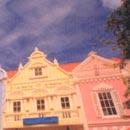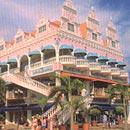ArubaThe Happy Island
Aruba is singled out in the Caribbean for the contrast of its amazingly blue waters, its hinterlands dotted by rocky formations, caves and abandoned mines. This island is a treasure yet to be unearthed, a paradise where there's always something new waiting just for you. In Aruba, only you are missing.
Aruba is a different island. From the moment you take a bird's-eye view from a plane, you know it's not similar to the rest of the Caribbean islands. Its rocks and blue-hued waters combine for a special blend that invites you to take an in-depth look at it, both along the coastlines and way deep inside.
Many location names here stem from an Indian past, and such words as Guadirikiri, Camacuri, Andicuri and Bushiri are good cases in point. Delving into the island's history to get to know its people a whole lot better promises to be an exciting journey. So, come aboard with us!
A LOOK INTO HISTORY Most research studies point to Caiquetios –members of the Arawak tribes whose remains date as far back as the year 1,000 BC- as the island's first-ever dwellers. Dregs of those long gone islanders' ceramic works, ornaments and artifacts are showcased at Aruba's Archeological Museum, a place teeming with history where visitors can dig out the way of life of those who first inhabited this small Caribbean island.
When Spaniards discovered Aruba, Caiquetios made up the majority of dwellers there. They had fled their continuous fights and rivalries with the Caribs and somehow made it to the island.
As Spanish traveler Alfonso de Ojeda landed on the island circa 1499, he scribbled on the logbook that he had arrived on an island of giants. Research studies conducted later on proved him right because the local population was taller than the average former residents of the West Indies.
As some traditions have it, the name Aruba comes from the term Oro huba (There's gold) , an expression uttered by the first Spaniards who thought they would find the coveted metal there. Others believe the name stems from the Arawak term oibubai, meaning guide.
Shortly after that, Spaniards abandoned the island for they rendered its lands as fruitless. In 1634, some Europeans settled down on the island to raise horses, the only profitable activity they thought they could benefit from there. Spaniards enslaved, sold and sent Caiquetios to La Hispaniola –currently the Dominican Republic- as workforce for the copper mines there.
By the end of the War of the Eight Years in 1636, the Dutch took over Aruba and stayed there for two centuries. During the Napoleonic Wars in 1805, the British ruled the island for a brief period of time until Holland won it back in 1816.
In1824, gold was discovered in the zone of Bushiribana. Some 3 million pounds were dug out until 1913 when gold mining was mothballed because it ceased to be a profitable business. Thus, the cropping of aloe vera began and soon became highly important. By 1951, Aruba used to produce roughly 30 percent of the world's aloe output.
In the early 20th century, gold was replaced by oil and huge refineries were installed. The Eagle Oil Company in the Eagle Beach area and New Jersey's Standard Oil in San Nicolas sparked off a great inflow of migrants and skilled workforce, especially from the U.S.
In 1983, Holland agreed to grant Aruba a special status –in force since 1986- that establishes the rule of a Governor appointed by the Queen, a 21-seat unicameral Parliament and the nation's own symbols.
Today, its economy depends mostly on the tourist industry that chips in 65 percent of the country's GNP after the company that owned the refinery pulled up stakes back in 1985. In 1986, Aruba separated from the Netherlands Antilles as the first step towards its full independence in 1996.
In the 1990s, the country's hotel accommodations doubled. The refinery reopened following its purchase by Coastal Corp. and gave the economy a remarkably new lease on life.
ARUBA TODAY Nowadays, Aruba is a cultural mosaic embracing over 40 different ethnic groups, something that's well ingrained in its history. The official languages are Dutch and Papiamento (a blend of Dutch, Spanish, English, French, Portuguese, different African dialects and Arawak). However, a considerable chunk of the population speaks English and Spanish, two languages that are taught in school since kids are ten years old and that certainly ease communication with the island's friendly and welcoming residents.
Aruba, spotted off the Venezuelan coasts and completely out of the hurricane beltway, can be reached by many means from anywhere else under the sun: by air through connection from the U.S., Europe and different points in Latin America, and by sea through an assortment of cruise companies that find in Aruba a bustling and well-outfitted port for those huge floating hotels to dock in.
The first impression you ever get upon arriving in Aruba is that of actually being in the Dutch Caribbean. No wonder in the capital Oranjestad, the houses are tidily lined up in rows and sport fresh coats of pastel-color paint.
Aruba's size makes it a perfect place to move around in, easily crossing from the coastline to the heart of the island in just a few minutes. As a matter of fact, both portions are packed with assorted offers. Its mild weather averaging 28 degrees Celsius and the smooth breeze that refreshes the environment stand for perfect complements to whatever choice we might really make.
If you're keenly bent on touring the shore in the first place, its blue waters will really pack a wallop. Their intense and bright shades stand out from the white sands. The 10-kilometer-long coastline is blessed with beaches for everyone and for any kind of activity: swimming, snorkeling, scuba diving, family vacations, romantic rendezvous... you name it. I must confess that taking a swim in Aruba's waters is one of those hard-to-forget pleasures.
You can easily drive your way to the beaches, let alone taking a cab or bus ride. The ideal thing to do is to visit several beaches during one single stay. You'll always find something new in each and every one of them that will surely leave you a nice aftertaste.
The island's hinterland is really something and goes beyond the wildest expectations for anywhere else in the Caribbean. Aruba is not green, but rather rocky, featuring indigenous excavations, abandoned gold mines, such caves brimming with history and ancient carvings as Guadirikiri or the rocky formations in Ayo and Casibari, former houses nicknamed cunucus. Other must-sees are the Jamanota Hill, the island's highest peak with 188 meters above sea level; the Hoffe Fontein, a natural spring with water spouting up from inside the land; gigantic cactuses and many other attractions spruced up by the trees that better symbolize the island: the dividivi (watapana in Papiamento), always pointing to the west as they are bent by the wind billowing from the sea.
The onset impression (its state-of-the-art airport is the first thing that strikes your attention) is that of being in a kind of European Caribbean where everything is tidy, comfy and lively, where whatever you want is right at your fingertips –shopping, strolls down the downtown area's bustling streets, stores, restaurants, fancy hotels and an environment that seems to be eagerly waiting for us.
To go shopping is one of Aruba's major attractions. We can happen on international companies and a variety of homemade items both down the capital's main street (G.F. Betico Croes, named after the nation's liberator) and in the city's countless malls and stores inside the hotels.
After such an all-embracing and brisk day, we can lay back at a spa and take advantage of the island's raw materials like mud, marine salts and aloe. Many hotels in Aruba are equipped with this kind of facilities, ready to provide the best services and cutting-edge techniques money can buy as far as massage, hydrotherapy and outdoor treatments (listening to the sound of the waves) are concerned.
The night closes in and nothing compares to gazing at an unforgettable Aruban sunset. They are pretty special in this neck of the woods. The spectacular view of the setting sun can be stared at from a restaurant deck as you enjoy the island's rich gourmet variety, right from the beach or just from our hotel.
All we need to do now is to splash into Aruba's nightlife. Offers here are amusing and suitable for everybody. Many hotels are outfitted with huge theaters that stage live shows performed by U.S. and Central American entertainers, as well as artists from other Caribbean nations like Cuba.
You could try to make a gamble at the casinos, or just take the bar tour that takes you for a spin around many of the island's night spots. Out of this fantastic bus ride, we can choose from the Kukoo Kunuku (wrapping up with a dinner under the stars) and the Chiva Paranda that ends up in Carlos ‘n Charlie's, with the extra choice of renting the place for an exclusive partying group. You can also watch a nightly show or simply take a stroll around the island.
If that's not fun enough, then we can climb aboard a cruise liner for a disco night, swing in ropes at midnight or diving into the sea, a kind of activity that has truly caught on here.
In a word, Aruba is a happy island, both for its inhabitants who always welcome their visitors as honor guests, and for tourists, for whom the island pans out to be a place to remember as it provides all the necessary ingredients –safety, fun, sports, shopping, calmness and one-and-only beaches in the Caribbean, let alone an astonishing and different environment- to give you the one choice you've been long yearning for.
There's no doubt Aruba is a very special island that lures people back to look into its roots and history and to live the heat of the moment in the same breath. Its mixture of cultures and its people go at great lengths to make you feel lovingly and welcomingly at home.

